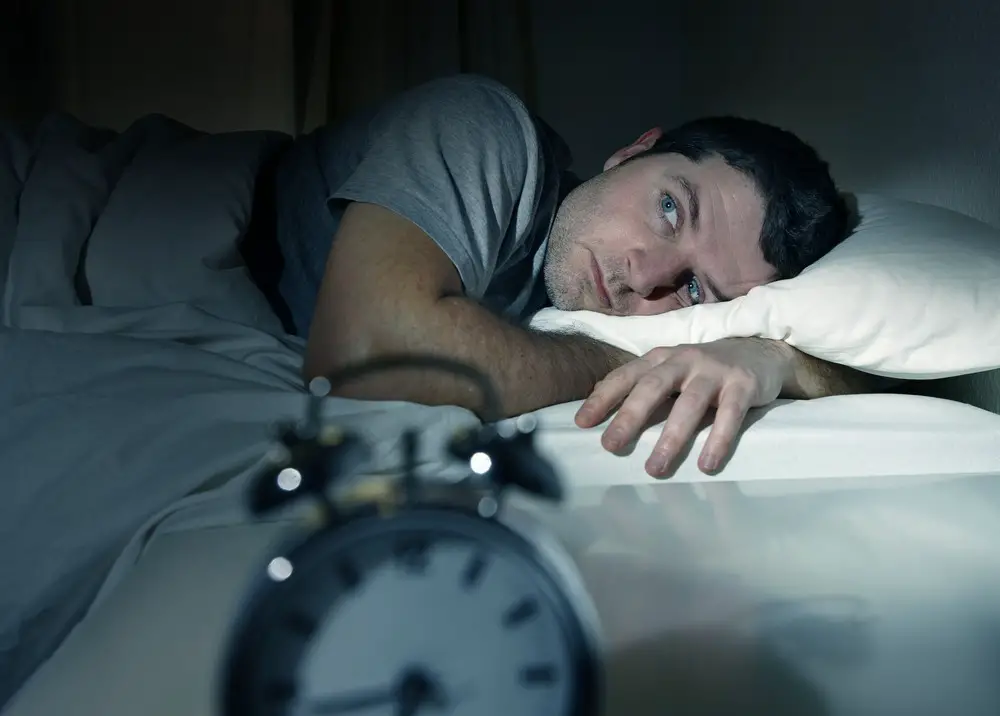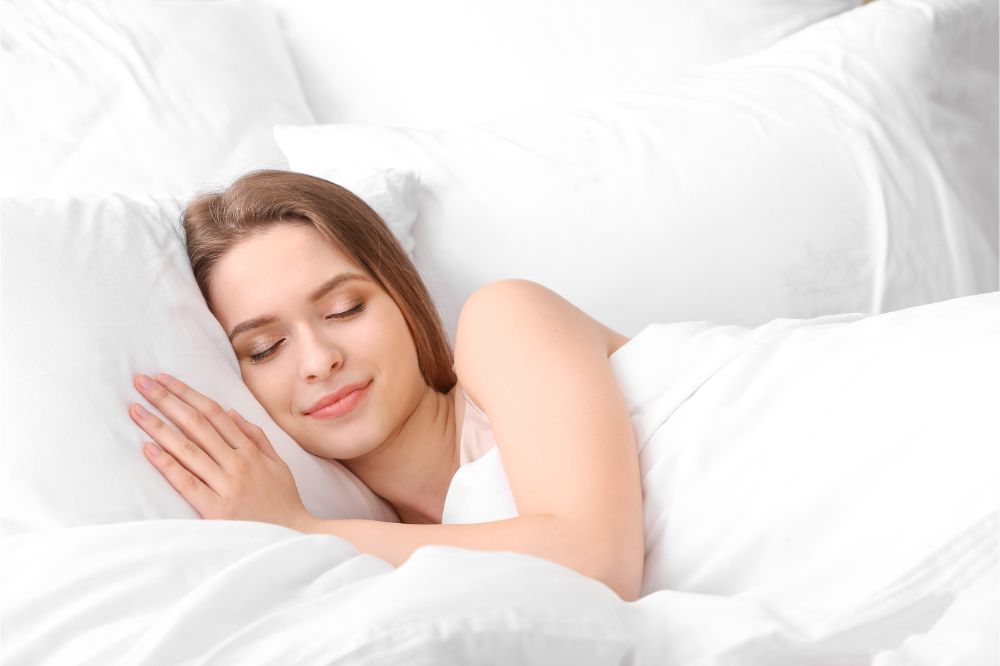As a BetterHelp affiliate, we receive compensation from BetterHelp if you purchase products or services through the links provided
Sleep apnea is a severe sleep disorder in which a person’s breathing stops and starts repeatedly during sleep. Individuals with this condition often experience loud snoring, restless sleep, and fatigue, even after a whole night’s rest.
Understanding the causes of sleep apnea is crucial for diagnosis and effective treatment. Recognizing the triggers and risk factors can lead to better management strategies, reducing the health risks associated with the disorder.
It is vital for individuals showing symptoms to grasp the underlying factors that contribute to sleep apnea, as early detection can significantly improve quality of life and overall health outcomes. Insight into this condition gives patients and healthcare providers the information to tackle sleep apnea head-on.
Understanding Sleep Apnea
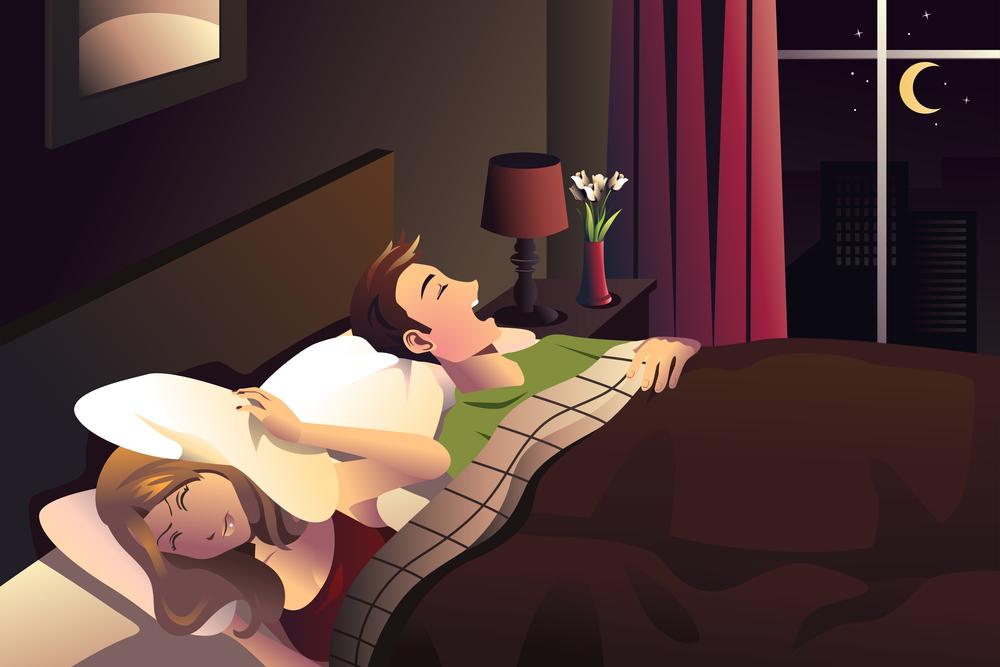
Gaining insight into how sleep apnea occurs and recognizing its significance can empower those affected to seek timely intervention. Let’s explore the mechanics of the condition and the crucial reasons for its timely recognition.
What Happens During Sleep Apnea?
During sleep apnea, your breathing repeatedly stops and starts. This can happen due to two main reasons:
- Obstruction: In obstructive sleep apnea (the most common type), the muscles supporting your throat relax, causing the airway to narrow or close. This blocks air from reaching your lungs.
- Brain malfunction: With central sleep apnea, your brain doesn’t correctly signal your muscles to breathe.
These breathing pauses trigger a survival reflex. Your brain briefly wakes you up just enough to reopen your airway and resume breathing. While this reflex keeps you alive, it disrupts your sleep cycle and prevents you from reaching deep, restorative sleep stages.
Why is Recognizing Sleep Apnea Important?
Sleep apnea is a severe condition that can lead to various health problems if left untreated. Here’s why recognizing it’s essential:
- Fragmented sleep: Constant sleep disruptions leave you tired and unrested during the day. This can lead to difficulty concentrating, memory problems, and mood swings.
- Health complications: Sleep apnea increases the risk of high blood pressure, heart disease, stroke, and diabetes. The repeated drops in oxygen levels during apneas strain your cardiovascular system, and chronic sleep deprivation can contribute to insulin resistance.
- Reduced quality of life: Daytime sleepiness can affect work performance, relationships, and overall well-being. You may struggle to stay awake while driving, miss work or social events due to fatigue, and experience irritability or difficulty concentrating.
Common Triggers of Sleep Apnea?
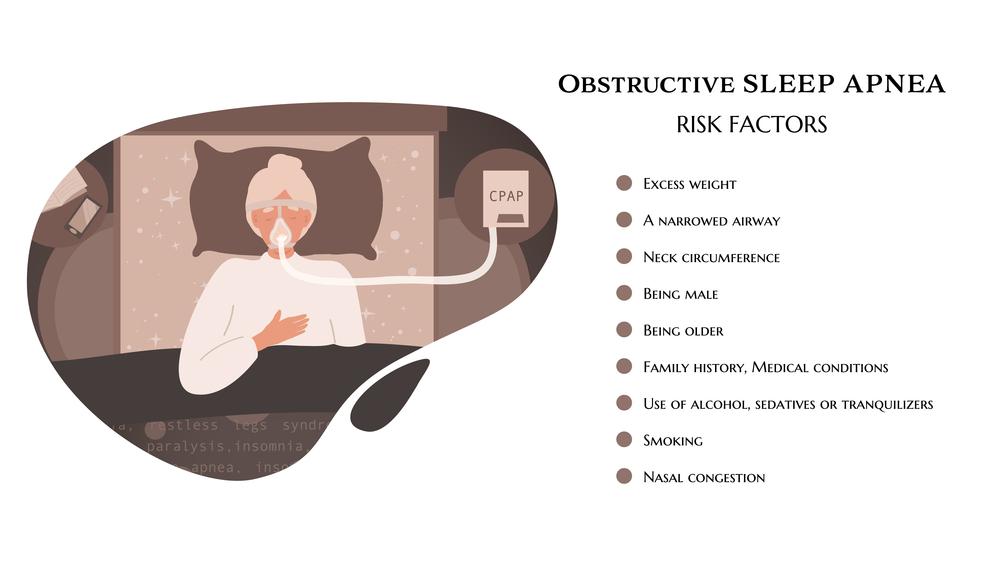
There are two main types of sleep apnea:
Obstructive Sleep Apnea (OSA)
This is the most prevalent kind, impacting millions of individuals. It occurs when your throat’s muscles relax while you’re asleep, either totally or severely restricting your airway. This obstruction disturbs your breathing, making you stop breathing frequently during the night.
Often, you won’t even realize these pauses are happening, but your brain briefly wakes you up to resume breathing, interrupting your sleep quality and leading to daytime fatigue.
Central sleep apnea (CSA)
This less common type of sleep apnea stems from a problem with the brain’s control of breathing. Unlike OSA, there’s no physical obstruction in your airway.
Instead, your brain fails to send the proper signals to the muscles that control breathing, leading to pauses during sleep. Central sleep apnea can be caused by underlying health conditions or medications.
Risk Factors Associated with Sleep Apnea
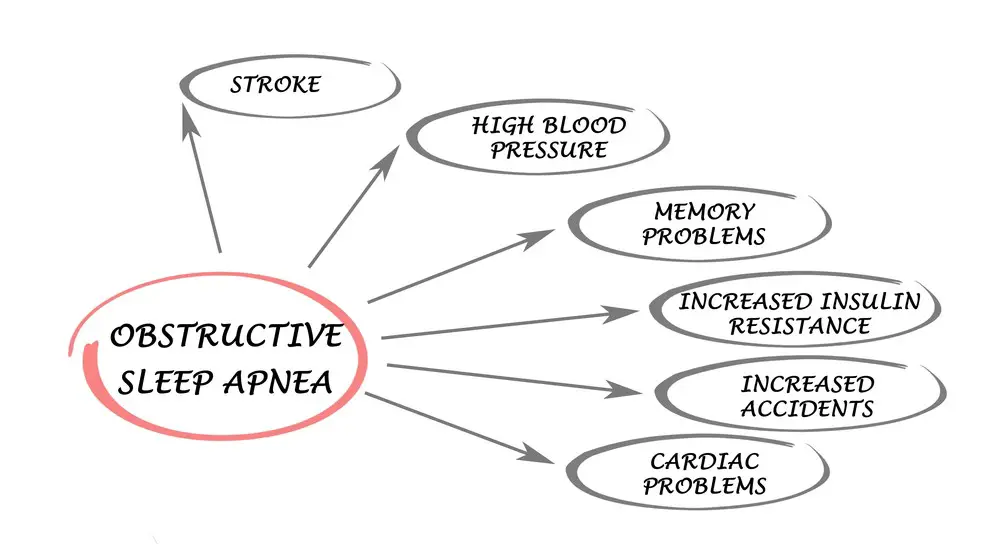
The triggers for sleep apnea worsen the condition in various ways, primarily by impacting the upper airway and breathing patterns during sleep.
Here’s a breakdown of how some common triggers aggravate sleep apnea:
Excess Weight
Fat deposits around the tongue and neck can physically narrow the airway. This makes it significantly harder for air to pass through when the throat muscles relax during sleep, leading to more frequent apneas.
Neck Circumference
A thicker neck reduces the space available for the airway. This limited space makes it easier for the airway to collapse during sleep, causing obstructions and sleep apnea.
Narrowed Airway
A naturally narrow airway is more susceptible to complete closure during sleep due to genetics, enlarged tonsils, or other reasons. Even slight relaxation of the throat muscles can cause a complete blockage in an already constricted airway, worsening sleep apnea.
Alcohol, Sedatives, and Tranquilizers
These substances relax the muscles that control your breathing and open your airway. This relaxation further narrows the airway during sleep, increasing the likelihood of apneas.
Smoking
Smoking irritates and inflames the tissues lining the upper airway, causing swelling and narrowing. This inflamed and narrowed airway is more prone to collapse during sleep, leading to worsened sleep apnea.
Nasal Congestion
Allergies, chronic sinus problems, or a deviated septum can all cause congestion in the nasal passages. This congestion makes it harder to breathe through your nose, forcing you to breathe through your mouth.
Mouth breathing during sleep dries out your throat, making the upper airway more likely to collapse, aggravating sleep apnea.
Physical Obstructions Leading to Sleep Apnea
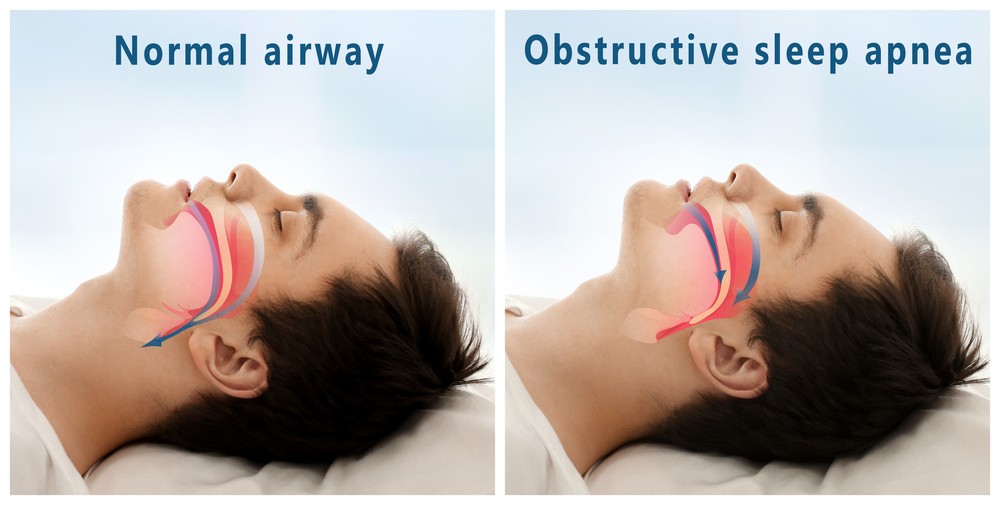
Understanding how physical blockages in the airways contribute to sleep apnea is key to addressing the root causes of the disorder.
Enlarged Tonsils and Adenoids
Enlarged tonsils and adenoids are common culprits in obstructive sleep apnea, especially in children. These tissues can block the airways during sleep, causing significant breathing interruptions.
Surgical removal often provides a permanent solution, improving nighttime breathing and reducing sleep apnea episodes.
Nasal Congestion and Sinus Issues
Chronic nasal congestion and sinus problems can make it difficult to breathe through the nose, which can trigger or worsen sleep apnea. Medication or surgery can help alleviate symptoms and improve sleep quality by managing these conditions.
Deviated Septum and Other Nasal Obstructions
A deviated septum — where the nasal septum is displaced to one side — is another structural issue that can impede airflow through the nose and exacerbate sleep apnea.
Corrective surgery, known as septoplasty, can align the septum and significantly improve airflow during sleep. Recognizing and treating such obstructions can greatly enhance sleep quality and overall health.
Health Conditions That Can Cause Sleep Apnea
Various health conditions can exacerbate or directly cause sleep apnea, impacting the body’s natural ability to maintain regular breathing patterns during sleep.
Impact of Endocrine Disorders
Endocrine disorders like hypothyroidism and acromegaly often lead to or worsen sleep apnea. Hypothyroidism causes metabolic changes that can increase tissue swelling, narrowing the airway.
Acromegaly, involving excess growth hormone, leads to anatomical changes that can obstruct airways. Addressing these hormonal imbalances is crucial for mitigating sleep apnea symptoms.
Respiratory Conditions and Sleep Apnea
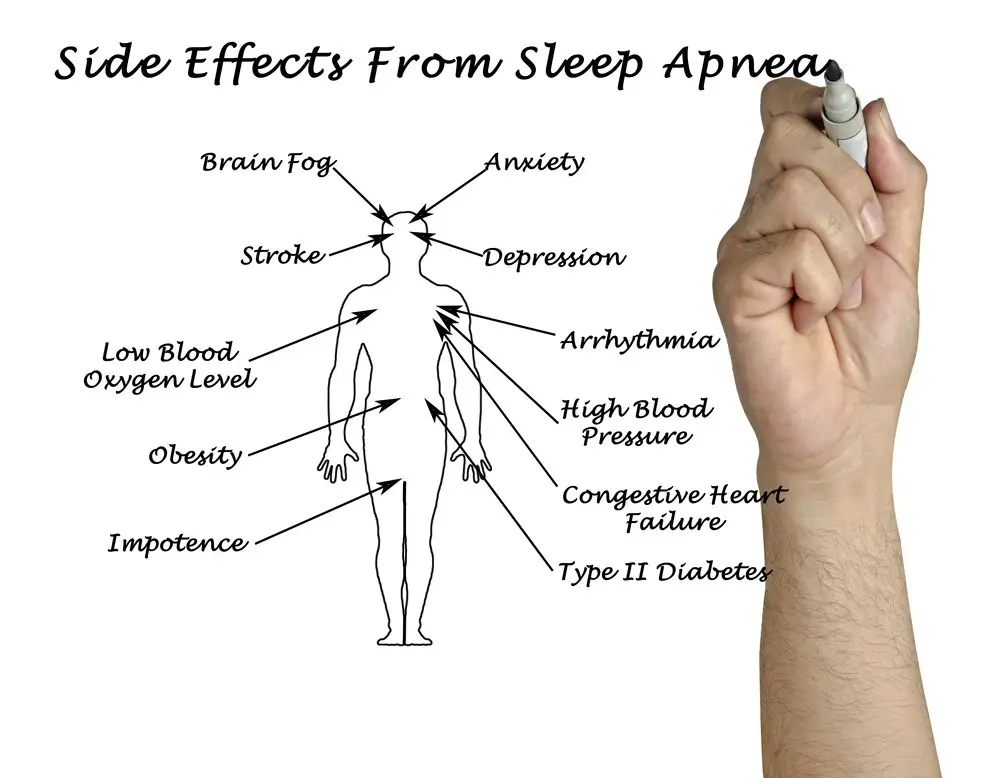
Chronic respiratory conditions such as asthma and COPD complicate sleep apnea because they affect airway resistance and lung function. Managing these respiratory conditions through medication or therapy can help reduce the occurrence of sleep apnea events and improve sleep quality.
Heart Conditions and Their Influence
Heart conditions like heart failure and atrial fibrillation may worsen sleep apnea. These conditions can lead to fluid shifts in the body, particularly at night, which increases the risk of throat obstruction during sleep.
Effective management of these heart conditions is often linked with a noticeable improvement in sleep apnea symptoms, showcasing the interconnectedness of cardiovascular health and sleep quality.
Lifestyle Habits Contributing to Sleep Apnea
Confident lifestyle choices significantly impact the likelihood and severity of sleep apnea. Understanding these factors can guide individuals toward making changes that promote better sleep and overall health.
Dietary Choices and Their Effects
Eating habits that lead to excessive weight gain can exacerbate sleep apnea. High-fat diets and excessive caloric intake contribute to obesity, a significant risk factor for the disorder. Adopting a balanced diet helps maintain a healthy weight and reduces the burden on respiratory functions during sleep.
Physical Inactivity
Lack of regular exercise contributes to poor health outcomes, including an increased risk of sleep apnea. Regular physical activity helps tone the muscles in the airway, making them less likely to collapse during sleep. It also aids in weight management, further reducing sleep apnea symptoms.
Alcohol Consumption and Smoking Habits
Alcohol relaxes the muscles in the throat, which can lead to increased airway obstruction during sleep. Similarly, smoking inflames and irritates the airways, making it more difficult to breathe during sleep. Reducing alcohol intake and quitting smoking are crucial steps for those seeking to improve sleep quality and reduce sleep apnea episodes.
Genetic Predisposition to Sleep Apnea
Genetics plays a significant role in determining who might be more vulnerable to developing sleep apnea. Delving into these factors can provide insights that aid in early detection and personalized treatment strategies.
Exploring Hereditary Factors
Certain genetic traits that affect facial structure, body weight, and muscle tone can predispose individuals to sleep apnea.
Families often share characteristics such as a narrow airway, recessed chin, or enlarged tonsils, which can increase the risk of developing the condition. Understanding these hereditary factors can prompt earlier screening and interventions.
Genetic Markers and Research Advances
Recent advances in genetic research have begun to identify specific markers associated with an increased risk of sleep apnea.
These findings help medical professionals understand the biological underpinnings of sleep apnea, leading to more targeted and effective treatments. Continued research is crucial for unraveling the complex genetic networks contributing to sleep apnea.
Family Health History and Its Role
A detailed family health history can be a powerful tool for predicting sleep apnea risk. Individuals with a family history of sleep apnea are encouraged to discuss this with their healthcare provider, as it may warrant earlier and more frequent evaluations.
Knowing family health patterns empowers patients and doctors to proactively manage potential sleep apnea, improving outcomes and quality of life.
Age and Gender Factors in Sleep Apnea

Age and gender significantly influence the risk and characteristics of sleep apnea. Understanding these differences helps tailor prevention and treatment approaches effectively.
How Age Affects Sleep Apnea
Age has a complex relationship with sleep apnea. Here’s a breakdown of how it affects the condition:
Increased Risk
- Muscle Weakening: The muscles that support the airway naturally weaken as we age. This weakness makes it harder for them to keep the airway open during sleep, increasing the risk of obstructive sleep apnea.
- Reduced Reflexes: The brain’s reflexes that control breathing may become less sensitive with age. This can contribute to central sleep apnea, where the brain doesn’t properly signal the muscles to breathe.
- Weight Gain: Age-related weight gain is typical, and excess weight is a significant risk factor for obstructive sleep apnea.
Potential Decrease in Severity
- Sleep Architecture Changes: Sleep patterns change with age. Older adults tend to spend less time in deep sleep stages, which are most affected by sleep apnea. This may lead to milder sleep apnea despite having similar breathing disruptions compared to younger individuals.
Important Considerations
- Overall Health: Age itself doesn’t directly cause sleep apnea. However, certain health conditions more common in older adults, like heart disease and high blood pressure, can worsen sleep apnea and its health consequences.
- Focus on Symptoms: While the severity of sleep apnea events might decrease with age, the daytime sleepiness and health risks associated with sleep apnea can still be significant. Recognizing symptoms like daytime fatigue, frequent nighttime awakenings, and morning headaches, regardless of age, is essential.
Gender-Specific Differences
There are some interesting gender-specific differences when it comes to sleep apnea. Here’s a breakdown of how sleep apnea can differ between men and women:
Prevalence
- Men at higher risk: Traditionally, sleep apnea was thought to be much more common in men, with estimates of a ratio of 8:1 (men to women).
- More even distribution: Recent studies suggest a ratio closer to 2:1, indicating sleep apnea is more prevalent in men but also affects many women.
Presentation of Symptoms
- Under-diagnosis in women: Women with sleep apnea may experience different symptoms compared to men. They might report more fatigue, insomnia, depression, and mood disturbances rather than the classic loud snoring often seen in men. This can lead to under-diagnosis of sleep apnea in women.
Severity
- Apnea-Hypopnea Index (AHI): On average, women tend to have a lower AHI, a measure of apnea events per hour of sleep, compared to men. This suggests they experience less severe breathing disruptions.
- Impact on Quality of Life: Despite potentially having a lower AHI, women with sleep apnea often report a more significant negative impact on their quality of life and may experience more daytime sleepiness even with a lower AHI.
Possible Reasons for Differences
- Hormonal fluctuations: Hormonal changes, especially around menopause, may play a role in increasing a woman’s risk of sleep apnea.
- Upper airway anatomy: Women tend to have narrower airways and different fat distribution patterns than men. This anatomical difference could influence the way sleep apnea manifests in women.
Menopause and Sleep Apnea in Women
Hormonal changes during menopause, such as decreases in progesterone and estrogen, can lead to an increased risk of sleep apnea in women. These hormones help maintain muscle tone in the throat, and their reduction can lead to more frequent airway collapses during sleep.
Recognizing the impact of menopause is crucial for diagnosing and treating sleep apnea in older women. Early intervention can improve sleep quality and overall health in menopausal women facing sleep disruptions.
Environmental Influences on Sleep Apnea
While anatomical factors can contribute to sleep apnea, environmental factors can also play a role in worsening the condition or making it harder to get a good night’s sleep. Here are some of the critical environmental influences on sleep apnea:
- Air quality: Air pollution, excellent particulate matter (PM10), has been linked to an increased severity of sleep apnea. Exposure to air pollution can irritate the airways and cause inflammation, narrowing the airway and worsening sleep apnea symptoms.
- Temperature: A hot bedroom can make sleeping harder and may worsen sleep apnea symptoms. When you’re hot, your body has to work harder to cool down, which can disrupt sleep.
- Noise: Noise can disrupt sleep and make falling and staying asleep harder. Even low levels of noise can be disruptive for people with sleep apnea.
- Light: Exposure to light at night can suppress melatonin production, a hormone that helps regulate sleep. This can make falling and staying asleep harder and worsen sleep apnea symptoms.
- Bedroom comfort: An uncomfortable mattress, pillows, or bedding can make it harder to get a good night’s sleep and may worsen sleep apnea symptoms.
If you have sleep apnea, you must be aware of these environmental factors and create a sleep environment conducive to good sleep.
Here are some tips:
- Improve air quality in your bedroom: Use an air purifier to remove pollutants from the air in your bedroom. You can also reduce your exposure to air pollution by limiting your time outdoors on days with high air pollution levels.
- Keep your bedroom cool: The ideal sleep temperature is around 60 degrees Fahrenheit (15.5 degrees Celsius).
- Reduce noise in your bedroom: Use earplugs or a white noise machine to block out noise.
- Make sure your bedroom is dark: Blackout curtains or an eye mask can help to block out light.
- Invest in a comfortable mattress, pillows, and bedding: Choose a supportive and comfy bed.
Symptoms and Diagnosis of Sleep Apnea
Identifying sleep apnea early is crucial for effective treatment and preventing complications. Awareness of symptoms and the diagnostic process are key steps toward managing this sleep disorder.
Recognizing Symptoms
Individuals often notice daytime sleepiness as a first sign, which indicates poor sleep quality due to frequent nighttime awakenings. Loud snoring, another common symptom, is typically reported by partners or family members and is a strong indicator of possible airway obstruction.
Perhaps most critically, episodes where breathing stops, observed by another person, signal a need for immediate medical evaluation.
Diagnostic Methods
To confirm a diagnosis of sleep apnea, doctors may recommend a polysomnography test. This overnight sleep study comprehensively records bodily functions during sleep, including brain activity, eye movement, heart rate, and blood oxygen levels.
For those who might find an overnight test inconvenient, home sleep apnea tests offer a more accessible option. These tests are more straightforward and focus primarily on airflow, breathing patterns, and oxygen levels, providing essential diagnostic insights without needing a hospital stay.
Potential Complications of Untreated Sleep Apnea
Ignoring sleep apnea not only disrupts sleep quality but also significantly increases the risk of several serious health complications. Recognizing these potential risks is crucial, motivating individuals to seek timely and appropriate treatment.
Cardiovascular Issues
Sleep apnea poses significant risks to cardiovascular health beyond hypertension. Repeated episodes of low oxygen levels during sleep lead to increased heart rate and greater stress on the cardiovascular system.
These conditions are pivotal factors in the development of more complex issues, including stroke and heart failure.
Hypertension
Persistent sleep apnea can lead to consistently higher blood pressure levels. Each episode of interrupted breathing at night increases stress on the body, which signals your hormonal systems to raise blood pressure levels.
Over time, this can lead to chronic hypertension, a significant risk factor for cardiovascular diseases.
Heart Disease
Frequent awakenings caused by sleep apnea severely strain the cardiovascular system. This ongoing stress can increase the risk of heart disease, including heart failure and atrial fibrillation.
It’s crucial for individuals experiencing symptoms of sleep apnea to monitor their heart health closely and engage in preventive measures.
Cognitive and Emotional Impact
Chronic sleep deprivation and intermittent oxygen shortages can have profound effects on brain health. These disruptions impair cognitive functions and emotional stability, making coping with stress and performing daily tasks more difficult.
Memory Problems
Interrupted sleep significantly impairs the brain’s ability to consolidate memories. Individuals with untreated sleep apnea often experience notable difficulties in remembering important daily tasks or events, which can affect their personal and professional lives.
Mood Disorders
Lack of restful sleep can severely affect emotional regulation, leading to conditions such as depression and anxiety. Effective management of sleep apnea can lead to noticeable improvements in mood and overall cognitive function, enhancing quality of life and emotional well-being.
Other Health Risks
Untreated sleep apnea can cascade into a myriad of other health issues, compounding the risk of developing secondary conditions that can severely impact life expectancy and quality.
Diabetes
Sleep apnea can interfere with glucose metabolism, increasing the risk of developing type 2 diabetes. Proper sleep and breathing management can help maintain better control over blood sugar levels, which is crucial for preventing diabetes or managing the condition more effectively if already diagnosed.
Metabolic Syndrome
This cluster of conditions, which includes high blood pressure, high sugar levels, and abnormal cholesterol levels, is more prevalent in individuals with untreated sleep apnea.
Addressing sleep apnea can be critical in managing these interconnected health issues. Proper treatment can mitigate the risks associated with metabolic syndrome, leading to a healthier life.
Treatment Options for Sleep Apnea
Effective management of sleep apnea can significantly improve sleep quality and overall health. Here are some targeted treatments that have proven successful for many patients.
Weight Loss
Losing weight can significantly reduce the severity of sleep apnea for overweight individuals. Even a modest reduction in body weight can decrease the number of apneic events per night, as less pressure is placed on the throat muscles.
Avoiding Alcohol and Smoking
Eliminating alcohol intake and smoking can alleviate sleep apnea symptoms. Alcohol relaxes the throat muscles, which can obstruct the airway during sleep while smoking increases inflammation and fluid retention in the airway. Both habits can significantly worsen sleep apnea.
Continuous Positive Airway Pressure (CPAP)
CPAP is a widely used treatment for moderate to severe sleep apnea. The device provides a steady stream of air through a mask, which keeps the airways open during sleep. Consistent use of CPAP can dramatically improve sleep quality and reduce health risks associated with sleep apnea.
Oral Appliances
Oral appliances are custom-fitted devices that adjust the position of the mouth and open the airway. They are less intrusive than CPAP machines and are often used for mild to moderate sleep apnea. These devices effectively prevent the tongue from blocking the throat and advance the jaw position to allow easier breathing.
Uvulopalatopharyngoplasty (UPPP)
UPPP is a surgical procedure that removes excess tissue from the throat to widen the airway. This can include uvula tissues, soft palate, and sometimes the tonsils. It is considered when other treatments have failed and are effective in reducing or eliminating obstructions in the airway.
Inspire Therapy
Inspire therapy is a newer treatment option involving a surgically implanted device that monitors breathing patterns and delivers mild stimulation to key airway muscles during sleep. This stimulation keeps the airway open, addressing the root cause of sleep apnea. Inspire therapy is typically recommended for patients who cannot tolerate CPAP.
Conclusion
Understanding what causes sleep apnea is vital for effective management and treatment. Factors range from lifestyle choices and physical obstructions to genetic predispositions and age-related changes. Recognizing these can significantly enhance the quality of sleep and overall health.
Everyone experiencing symptoms or at risk should consult healthcare providers for a proper diagnosis and personalized treatment plan. Early intervention based on professional advice can prevent complications and improve quality of life.
Encourage loved ones who may show signs of sleep apnea to seek medical guidance. With the right approach, managing sleep apnea becomes a more straightforward path to better sleep and healthier living.
- Stress Management: What is the Relationship Between Stress and Addiction? - June 28, 2024
- Exploring Techniques to Maintain a Healthy Lifestyle without Drugs - May 28, 2024
- How Acupuncture Helps Treat Chronic Fatigue Syndrome - May 28, 2024
This site contains affiliate links to products. We will receive a commission for purchases made through these links.


